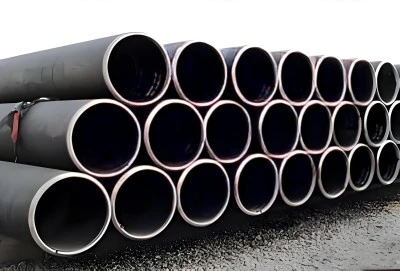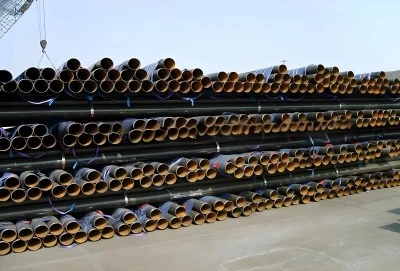API 5L Grade B and API 5L X42 are two important grades of steel pipe specified by the American Petroleum Institute (API) for use in oil and gas pipeline transportation systems. While both grades fall under the API 5L specification for line pipe, they have distinct characteristics and capabilities that make them suitable for different applications. API 5L Grade B represents a basic grade that has been widely used in the pipeline industry for many years, while X42 is part of the higher strength X-grade series developed to meet more demanding operating conditions.
The primary distinction between these two grades lies in their mechanical properties, particularly yield strength and tensile strength. The designation "X42" indicates a minimum yield strength of 42,000 psi (290 MPa), while Grade B has a lower minimum yield strength of 35,000 psi (241 MPa). This fundamental difference influences their respective applications and performance capabilities in pipeline systems. Understanding these distinctions is crucial for engineers and procurement professionals when selecting the appropriate pipe grade for specific project requirements.
|
|
|
Strength
The strength characteristics of API 5L X42 and Grade B pipes represent one of the most significant differentiating factors between these two grades. API 5L X42 pipe demonstrates superior strength properties, with a minimum yield strength of 42,000 psi (290 MPa) and a minimum tensile strength of 60,000 psi (414 MPa). In contrast, API 5L Grade B pipe features a minimum yield strength of 35,000 psi (241 MPa) and a minimum tensile strength of 60,000 psi (414 MPa). This higher yield strength in X42 provides enhanced resistance to deformation under pressure and improved structural integrity in demanding applications.
The increased strength of X42 pipe is achieved through careful control of the chemical composition and manufacturing processes. The steel undergoes specific heat treatment procedures and controlled cooling rates to develop the desired microstructure that yields these superior strength properties. This enhanced strength capability makes X42 pipe particularly suitable for applications involving higher operating pressures and more severe service conditions. The higher yield strength also allows for potential reduction in wall thickness compared to Grade B pipe for the same pressure rating, which can result in material savings and reduced installation costs in certain applications.
It's important to note that while X42 offers higher strength capabilities, this doesn't automatically make it the better choice for all applications. The selection between these grades should be based on specific project requirements, including operating pressure, temperature conditions, and environmental factors. The higher strength of X42 comes with additional manufacturing requirements and typically higher costs, which must be justified by the application requirements.
Material Composition
The material composition of API 5L Grade B and X42 pipes exhibits subtle but important differences that contribute to their distinct mechanical properties. Both grades are fundamentally carbon steels, but X42 typically incorporates a more carefully controlled chemical composition to achieve its higher strength levels. The carbon content in X42 is usually maintained within a tighter range compared to Grade B, and additional alloying elements may be present in carefully controlled amounts to enhance specific properties.
In API 5L X42 pipe, the carbon content typically ranges from 0.22% to 0.26%, while Grade B usually contains 0.22% carbon maximum. The manganese content in X42 is often slightly higher, ranging from 1.15% to 1.50%, compared to Grade B's typical range of 0.95% to 1.20%. These subtle variations in composition, combined with controlled processing parameters, contribute to the development of the desired microstructure and mechanical properties. The presence of other alloying elements such as silicon, phosphorus, and sulfur is also carefully controlled to ensure optimal performance characteristics.
The manufacturing process for both grades involves stringent quality control measures, but X42 typically requires more precise control of heating and cooling rates during production to achieve its specified properties. The composition must be carefully balanced to maintain good weldability while achieving the required strength levels. This balance is crucial as excessive alloying can negatively impact fabrication properties and increase production costs.
Application
The application scope for API 5L Grade B and X42 pipes varies significantly based on their respective capabilities and performance characteristics. Grade B pipe has established itself as a reliable choice for general pipeline applications where moderate pressure ratings and standard service conditions prevail. These applications typically include water transmission lines, low-pressure natural gas distribution systems, and oil transportation pipelines operating under normal conditions. The cost-effectiveness and proven track record of Grade B make it particularly attractive for projects where extreme operating conditions are not a concern.
API 5L X42 pipe finds its niche in more demanding applications where higher pressure ratings or more challenging service conditions are encountered. This grade is commonly specified for offshore pipeline systems, gathering lines in oil and gas fields, and transmission pipelines operating at higher pressures. The enhanced strength properties of X42 make it particularly suitable for sour service applications where exposure to hydrogen sulfide (H2S) requires additional material resistance. The superior mechanical properties of X42 also make it a preferred choice in geographical areas where ground movement or seismic activity may impose additional stresses on the pipeline system.
In terms of specific operating environments, Grade B is commonly used in ambient temperature applications with moderate pressure requirements, typically up to 740 psi (5.1 MPa) for standard wall thicknesses. X42, with its higher strength capabilities, can handle operating pressures up to 1,000 psi (6.9 MPa) or higher, depending on the wall thickness and design factors. The selection between these grades often involves careful consideration of factors such as operating pressure, temperature, environmental conditions, and cost considerations.
China API 5L X42 Pipe Supplier
LONGMA GROUP has established itself as a leading manufacturer and supplier of API 5L X42 pipe, maintaining stringent quality control standards in accordance with international specifications. The company's product offerings include both PSL1 and PSL2 grades, catering to diverse project requirements and applications in the oil and gas industry. Each pipe undergoes rigorous testing and inspection procedures to ensure compliance with API standards and customer specifications.
The manufacturing capabilities at LONGMA GROUP encompass a wide range of sizes and wall thicknesses in API 5L X42 pipe, with advanced production facilities equipped to handle both standard and custom orders. The company maintains comprehensive quality management systems certified to international standards, ensuring consistent product quality and reliability. For professional consultation and detailed product information, interested parties are encouraged to contact the sales team at info@longma-group.com.














